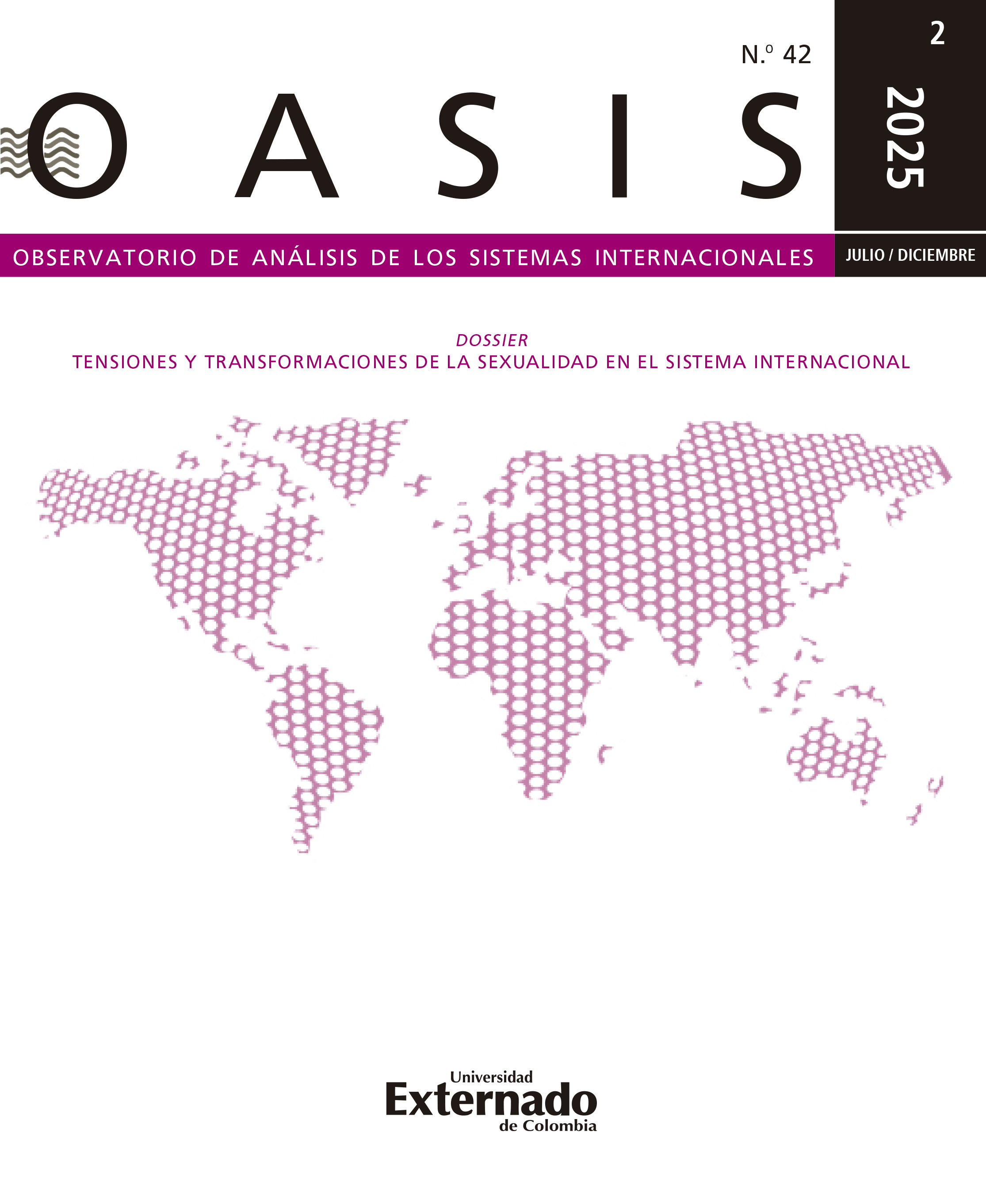Comprensiones enactivas en torno a la identidad de género: corporalidades emergentes en un contexto globalizado
Enactive Understandings of Gender Identity: emerging embodiments in a globalized context
Contenido principal del artículo
Resumen
En un mundo globalizado, los desafíos relacionados con la identidad de género se intensifican debido a la exposición a diversas normas y expectativas culturales que a menudo entran en conflicto. En este contexto, es fundamental distinguir entre género, orientación sexual y sexo, ya que la confusión entre estos conceptos dificulta el reconocimiento y la comprensión de la diversidad de identidades. Este artículo explora la percepción y las posibilidades que ofrece el enfoque enactivo que enfatiza la interacción entre el cuerpo y el entorno, para entender la constitución de la identidad de género. El objetivo es identificar cómo la percepción facilita esta conformación mediante el reconocimiento de uno mismo y de los demás, así como reflexionar sobre el impacto de estas teorías en la práctica psicológica y en la comprensión de la diversidad identitaria, especialmente en contextos donde la inclusión y el reconocimiento son esenciales para el bienestar individual y colectivo. Desde esta perspectiva, la identidad de género se concibe como un proceso dinámico en el que, a través de la experiencia corporal y social, el individuo construye significados y responde a las normas culturales.
Además, se destacan los puntos de contacto entre el enactivismo y la performatividad de género, resaltando cómo ambos rechazan una esencia predefinida y subrayan la influencia de las relaciones sociales y el contexto. Se identifican oportunidades en la literatura para profundizar en la comprensión de la identidad de género, promoviendo investigaciones que vinculen su constitución con experiencias corpóreas y socioculturales.
Palabras clave
Descargas
Detalles del artículo
Referencias / Ver
Acker, J. (2004). Gender, capitalism and globalization. Critical Sociology, 30, 17-41. https://doi.org/10.1163/156916304322981668
Albarracín, M. y Poirier, P. (2022). Enacting gender: An enactive-ecological account of gender and its fluidity. Frontiers in Psychology, 13. https://doi.org/10.3389/fpsyg.2022.772287
Alzate, M. M., Matas, J. L., Dongarwar, D. y Hirth, J. M. (2024). Gender role beliefs and adolescent pregnancy in Colombia: Findings from the 2015 DHS survey. Culture, Health & Sexuality, 26, 30-45. https://doi.org/10.1080/13691058.2023.2182453
Arnberg, K., Larsen, E. y Östman, A.-C. (2022). Gender and economic history in the Nordic countries. Scandinavian Economic History Review, 70, 113-122. https://doi.org/10.108 0/03585522.2022.2078403
Arora, D., Braunstein, E. y Seguino, S. (2023). A macro analysis of gender segregation and job quality in Latin America. World Development, 164, 106-153. https://doi.org/10.1016/j. worlddev.2022.106153
Biblioteca del Congreso Nacional de Chile (2017). Evolución del concepto de género: Identidad de género y la orientación sexual. Departamento de Estudios, Extensión y Publicaciones.
Blackburn, R. M., Browne, J., Brooks, B. y Jarman, J. (2002). Explaining gender segregation. The British Journal of Sociology, 53, 513-536. https://doi.org/10.1080/0007131022000021461
Brancazio, N. (2019). Gender and the senses of agency. Phenomenology and the Cognitive Sciences, 18, 425-440. https://doi.org/10.1007/s11097- 0189581-z
Butler, J. (1998). Actos performativos y constitución del género: un ensayo sobre fenomenología y teoría feminista. Debate Feminista, 18, 296- 314. http://www.jstor.org/stable/42625381
Butler, J. (2006). Deshacer el género. Paidós.
Butnor, A. y MacKenzie, M. (2022). Enactivism and Gender Performativity. Oxford University Press. https:// doi.org/10.1093/ oso/9780190867614.003.0011
Ciurlo, A. (2015). La migración femenina y los cambios en las relaciones de género en las familias: el caso de las transmigrantes colombianas en Italia. oasis, 55. https://doi. org/10.18601/16577558.n21.04
Coffey, J. (2019). Creating distance from body issues: Exploring new materialist feminist possibilities for renegotiating gendered embodiment. Leisure Sciences, 41, 72-90. https://doi.org/1 0.1080/01490400.2018.1539685
Congly, S. E. y Brownfield, K. A. (2020). Distinguishing Between Sex and Gender Is Critical. Transplantation, 104, e57-e57. https://doi.org/10.1097/TP.0000000000002945
Conte, J. (2018). Sex versus Gender. Oxford University Press. https: //doi.org/10.1093/ obo/9780199756384-0153
Crippen, M. y Rolla, G. (2022). Faces and situational Agency. Topoi, 41, 659-670. https://doi. org/10.1007/s11245-022-09816-y
D’Argenio, G., Finisguerra, A. y Urgesi, C. (2022). Experience-dependent reshaping of body gender perception. Psychological Research, 86, 1184-1202. https://doi.org/10.1007/s00426- 021-01569-4
De Beauvoir, S. (1981). El segundo sexo. Ediciones Cátedra.
Di Paolo, E. A. (2009). The social and enactive mind. Phenomenology and the Cognitive Sciences, 8, 409-415. https://doi.org/10.1007/s11097009- 9143-5
Di Paolo, E. A., Cuffari, E. C., y De Jaegher, H. (2018). Linguistic bodies: The continuity between life and language. MIT Press.
Di Paolo, E. A. y Thompson, E. (2024). The enactive approach. The Routledge Handbook of Embodied Cognition (pp. 85-97). Routledge.
Eagly, A. H., Nater, C., Miller, D. I., Kaufmann, M. y Sczesny, S. (2020). Gender stereotypes have changed: A cross-temporal meta-analysis of U.S. public opinion polls from 1946 to 2018. American Psychologist, 75, 301-315. https://doi.org/10.1037/amp0000494
Erikson, E. H. (1968). Identity: Youth and crisis. Norton & Co.
Farfán, E. J. (2021). La constitución del sujeto y de la alteridad. Una conversación con Gilbert Simondon [Tesis de pregrado]. Universidad Pedagógica Nacional.
Fausto-Sterling, A. (2019). Gender/Sex, Sexual Orientation, and Identity Are in the Body: How Did They Get There? The Journal of Sex Research, 56(4-5), 529-555. https://doi.org/1 0.1080/00224499.2019.1581883
Gallagher, S. (2023). Embodied and Enactive Approaches to Cognition. Cambridge University Press. https://doi.org/10.1017/9781009209793
Gallagher, S. y Bower, M. (2013). Making enactivism even more embodied. Avant: Trends in Interdisciplinary Studies (2), 232-247. https:// doi. org/10.26913/50202014.0109.0011
Gallagher, S. y Lindgren, R. (2015). Enactive metaphors: Learning through full-body engagement. Educational Psychology Review, 27, 391-404. https://doi.org/10.1007/s10648- 015-9327-1
Gallagher, S. y Zahavi, D. (2020). The Phenomenological Mind. Routledge. https://doi. org/10.4324/9780429319792
García-Leiva, P. (2005). Identidad de género: Modelos explicativos. Escritos de Psicología, 71-81. https://www.redalyc.org/ articulo.oa?id=271020873007
Gibson, J. J. (1979). The Ecological Approach to Visual Perception. The Psychology Press.
Giuliano, P. (2017). Gender: An Historical Perspective. National Bureau of Economic Research. https://doi.org/10.3386/w23635
Guzmán, V. (2002). Las relaciones de género en un mundo global. Cepal.
Halberg, C. (2023). Neurosexism, neurofeminism, and neurocentrism: From gendered brains to embodied minds. NORA–Nordic Journal of Feminist and Gender Research, 31, 279-291. https://doi.org/10.1080/08038740.2022.21 55244
Hekmatpour, P. (2024). World society, cultural diversity, and gender gap in political empowerment: A cross-national comparative analysis. Comparative Sociology, 23, 461-498. https:// doi.org/https://doi.org/10.1163/15691330- bja10114
Heredia, E. B. y Carrillo, M. J. C. (2008). Gender perspective in the context of Spanish academic psychology. Psicothema, 20, 236-42.
Hipólito, I., Winkle, K. y Lie, M. (2023). Enactive artificial intelligence: Subverting gender norms in human-robot interaction. Frontiers in Neurorobotics, 17. https://doi.org/10.3389/ fnbot.2023.1149303
Hutto, D. D. y Myin, E. (2013). Radicalizing Enactivism: Basic Minds Without Content. MIT press.
Kahl, S. y Kopp, S. (2023). Intertwining the social and the cognitive loops: Socially enactive cognition for human-compatible interactive systems. Philosophical Transactions of the Royal Society B: Biological Sciences, 378(1875). https://doi.org/10.1098/rstb.2021.0474
Keller, W. y Utar, H. (2022). Globalization, gender, and the family. The Review of Economic Studies, 89, 3381-3409. https://doi.org/10.1093/ restud/rdac012
Kimmel, M., Rogler, C. y Tanja, S. (2021). Meaning in movement, embodied practice, and communication. Berghahn Books. https://doi. org/10.1515/9781800732453
Kwan, S. y Haltom, T. M. (2020). Gender and Bodies. Oxford University Press. https://doi. org/10.1093/obo/9780199756384-0236
Maccoby, E. E. (2000). Perspectives on gender development. International Journal of Behavioral Development, 24, 398-406. https://doi.org/10.1080/016502500750037946
Maccoby, E. E. y Jacklin, C. N. (1987). Gender Segregation in Childhood. En H. W. Reese (Ed.), Advances in Child Development and Behavior (pp. 239-287). Academic Press. https:// doi.org/10.1016/S0065-2407(08)60404-8
Menin, F. J. (2015). La identidad de género como derecho humano: la legislación argentina. Anuario de Derecho Constitucional. Colombia 21, 627-641.
Merleau-Ponty, M. (1957). Fenomenología de la percepción. Fondo de Cultura Económica.
More, R. A. (2023). Roles of gender in modern society. International Journal for Multidisciplinary Research, 5. https://doi.org/10.36948/ ijfmr.2023.v05i02.2720
Muehlenhard, C. L. y Peterson, Z. D. (2011). Distinguishing Between Sex and Gender: History, Current Conceptualizations, and Implications. Sex Roles, 64, 791-803. https://doi. org/10.1007/s11199-011-9932-5
Noë, A. (2021). The enactive approach: A briefer statement, with some remarks on “radical enactivism”. Phenomenology and the Cognitive Sciences, 20, 957-970. https://doi. org/10.1007/s11097-021-09754-x
O’Regan, J. K. y Noë, A. (2001). A sensorimotor account of vision and visual consciousness. Behavioral and Brain Sciences, 24, 939-973. https://doi.org/10.1017/S0140525X01000115
Oviedo, G. L. O. (2004). La definición del concepto de percepción en psicología con base en la teoría Gestalt. Revista de Estudios Sociales, 89-96.
Oxford, S. y McLachlan, F. (2018). “You have to play like a man, but still be a woman”: Young female colombians negotiating gender through participation in a Sport for Development and Peace (SDP) Organization. Sociology of Sport Journal, 35, 258-267. https://doi.org/10.1123/ ssj.2017-0088
Oxford, S. y Spaaij, R. (2019). Gender relations and sport for development in Colombia: A decolonial feminist analysis. Leisure Sciences, 41, 54-71. https://doi.org/10.1080/01490400.2 018.1539679
Palumbo, R., Laeng, B. y Tommasi, L. (2013). Gender-specific aftereffects following adaptation to silhouettes of human bodies. Visual Cognition, 21, 1-12. https://doi.org/10.1080/135 06285.2012.753970
Robertson, I. (2023). The unbearable rightness of seeing? Conceptualism, enactivism, and skilled engagement. Synthese, 202, 173. https://doi.org/10.1007/s11229-023-04385-y
Rojas, A. L. D. (2020). Consideraciones sobre la percepción desde la perspectiva enactiva. Principia: An International Journal of Epistemology, 24, 29-49. https://doi.org/10.5007/1808- 1711.2020v24n1p29
Rodríguez, C. (2020). Globalization and gender identity: Challenges and transformations in the digital era. Gender Studies Review, 12(3), 189-210.
Ronconi, F., Zemaitis, S., Barrena, A. y Alessi, D. (2020). La sexualidad: entre lo subjetivo, lo biológico y lo social. Identidades de género, expresión de género, orientación sexual. Universidad Nacional de La Plata.
Sánchez, T. (2009). Desarrollo de la identidad de género desde una perspectiva psico-socio-cultural: un recorrido conceptual. Revista Interamericana de Psicología, 43, 250-259. https://www.redalyc.org/articulo. oa?id=28412891006
Sepúlveda-Pedro, M. A. (2023). Enactive Cognition in Place. Springer International Publishing. https://doi.org/10.1007/978-3-031-20282-7
Shew, M. M. y Garchar, K. (2020). Philosophy for Girls: An Invitation to the Life of Thought. Oxford University Press.
Sheets-Johnstone, M. (2011). The Primacy of Movement (Expanded 2 ed.). John Benjamins Publishing. https://doi.org/10.1075/aicr.82
Soriano, J. B. y Polverino, F. (2023). Sex and gender in COPD and asthma. European Respirator y Journal , 62. https://doi. org/10.1183/13993003.01505-2023
Stark, L. P. (1991). Traditional gender role beliefs and individual outcomes: An exploratory analysis. Sex Roles, 24, 639-650. https://doi. org/10.1007/BF00288419
Sudkämper, A., Ryan, M. K., Kirby, T. A. y Morgenroth, T. (2020). A comprehensive measure of attitudes and behaviour: Development of the Support for Gender Equality among Men Scale. European Journal of Social Psychology, 50, 256-277. https://doi.org/10.1002/ ejsp.2629
Terry, A. (2016). Reconceptualizing gender: A historical perspective from structure to process and intersectionality. Journal of Research in Gender Studies, 6, 69. https://doi.org/10.22381/ JRGS6220164
Thompson, E. y Varela, F. J. (2001). Radical embodiment: Neural dynamics and consciousness. Trends in Cognitive Sciences, 5, 418-425. https:// doi.org/10.1016/S1364- 6613(00)01750-2
Torices Vidal, J. R. (2017). Emoción y percepción: una aproximación ecológica. Análisis filosófico, 37, 5-26.
Ulloa, A. (2019). Gender and feminist geography in Colombia. Gender, Place & Culture, 26, 1021-1031. https://doi.org/10.1080/096636 9X.2018.1554558
Valderrama, J. C. (2023). Aproximaciones desde la cognición corporeizada: las manos y cómo se involucran en la solución de problemas. Límite, 18. https://doi.org/10.4067/s0718- 50652023000100212
Valentova, M. (2016). How do traditional gender roles relate to social cohesion? Focus on differences between women and men. Social Indicators Research, 127, 153-178. https://doi. org/10.1007/s11205-0150961-2
Valtonen, A. y Närvänen, E. (2015). Gendered reading of the body in the bed. Journal of Marketing Management, 31, 1583-1601. https:// doi.org/10. 1080/0267257X.2015.1061038
Van Driel, F. (2020). The gender question in globalization: Changing perspectives and practices. Routledge.
Varela, F., Thompson, E. y Rosch, E. (1993). The Embodied Mind: Cognitive Science and Human Experience. MIT Press.
Vergara, H. (2010). La conciencia de lo corporal: una visión fenomenológica-cognitiva. Ideas y Valores, 59, 25-47. http://www.scielo.org.co/scielo.php?script=sci_arttext&pid=S012000622010000100002&lng=en&nrm=iso &tlng=es
Wehrle, M. (2021). ‘Bodies (that) matter’: The role of habit formation for identity. Phenomenology and the Cognitive Sciences, 20, 365-386. https://doi.org/10.1007/s11097-020-09703-0










